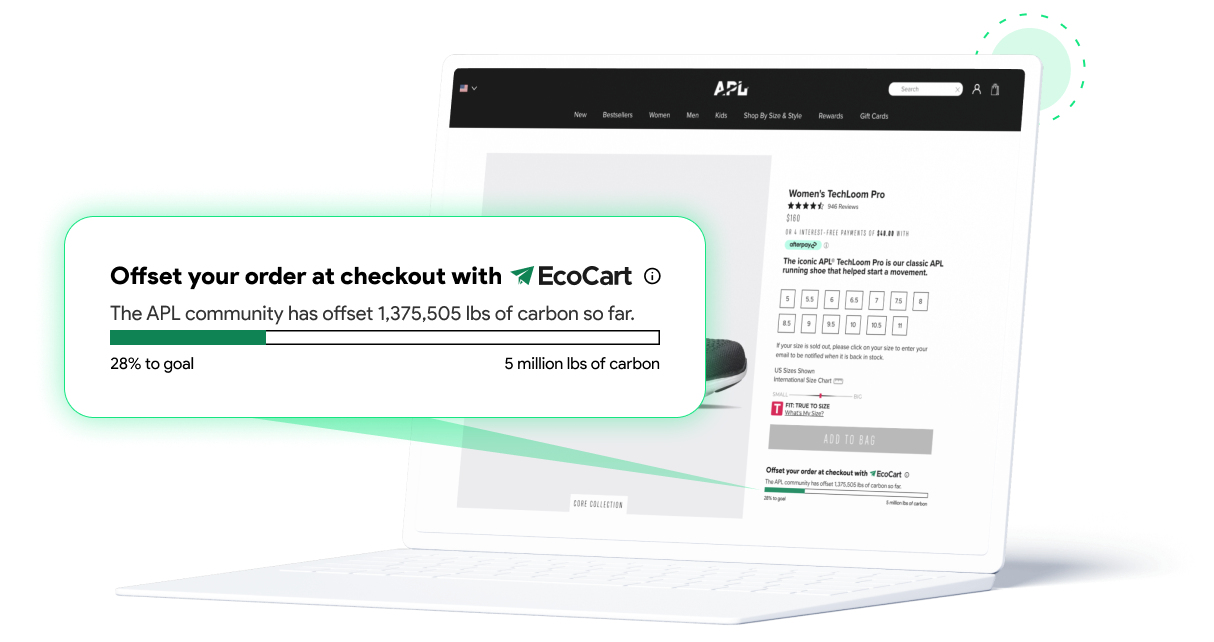Climate contribution represents a critical step for ecommerce businesses in their journey towards environmental stewardship. Unlike traditional sustainability strategies focused solely on reducing carbon footprints, climate contribution actively engages companies in supporting carbon projects that drive tangible improvements in our planet’s health.
This approach not only amplifies a business’s impact on combating climate change but also delineates a clear distinction from carbon offsetting. While both strategies aim to counterbalance emissions, climate contribution is distinguished by its direct investment in projects that yield verifiable, long-term environmental benefits.
Herein lies our comprehensive guide to understanding climate contribution: its significance for ecommerce entities, and how it diverges from the conventional carbon offsetting narrative to offer a more impactful route to climate action.
What Is A Climate Contribution?
A climate contribution refers to the financial commitment provided by an organization to support climate action initiatives that go beyond its own carbon reduction targets. This term, endorsed by the Net Zero Initiative, distinguishes such efforts from the conventional carbon offsetting practices.
Unlike carbon offsets, climate contributions are not applied towards an organization’s carbon neutrality goals. Instead, they serve as a vital complement to Environmental, Social, and Governance (ESG) strategies, enhancing the collective fight against global warming without directly contributing to the company’s emission reduction metrics.
Why Businesses Need Climate Contributions
Climate experts have determined that we need to make big changes if we are to keep global temperatures below dangerous levels. Although the Paris Agreement gained net zero pledges from nearly 200 parties, not everyone has agreed to participate.
Even with a concerted effort from a large number of entities, it’s going to be a challenge to reach important carbon emission reduction targets. Companies are encouraged to invest in carbon reduction projects while pursuing their net zero ambitions, thereby assuming responsibility for a greater portion of the carbon emissions dilemma.
This approach not only addresses the gaps left by entities reluctant to engage in climate action but also signifies a more accountable and impactful stance in the global effort to mitigate climate change.
Download our FREE ebook:

Here are some of the top reasons why contributions are vital to ecommerce businesses.
- Customer expectations: According to a 2023 survey by Business News Daily, 72% of respondents worldwide reported that they actively seek environmentally friendly products. As ecommerce has grown, customers have become aware of its greenhouse gas emissions associated with deliveries and transport. Customers who care about the environmental footprint of the companies they support pay attention to how online businesses address their carbon dioxide output. Making climate contributions alongside a robust sustainability strategy shows potential customers that your company is making true efforts for climate change action.
- Avoid greenwashing: Because climate contributions go beyond your company’s GHG emissions to support climate change action, it avoids greenwashing accusations that often arise with climate offsets. Although the two are similar, offsetting is often associated with a business-as-usual approach, as companies can use carbon offsets to claim that they are taking responsibility for their carbon dioxide footprint while making no changes. Conversely, climate contributions are not included in a company’s carbon accounting. This lends authenticity to a company’s sustainability approach.
- ESG certification: Even though contributions do not contribute to the reduction of a company’s carbon footprint, they can be included in sustainability reporting and provide support for ESG certification. It displays high levels of commitment to reducing your footprint, which helps you achieve certain criteria for different green certifications.
- Go above and beyond: Even if your company is carbon neutral certified, contributions can be made to support global climate efforts. The net zero targets of the Paris Agreement are lofty, and if we, as a global community, are to achieve them in time, then all stakeholders need to pitch in as much as they can. Remember, even if your company has earned carbon neutrality now, it has likely carried a carbon footprint at one point. Continuing to make climate contributions allows your organization to take responsibility for past emissions and display its commitment to sustainable action and environmental duty.
Want to know where your business stands? Get your sustainability scorecard with our quiz:
Carbon Offsetting vs. Climate Contribution
Carbon offsets (also known as carbon compensation) and climate contribution are incredibly similar, with a few key differences. Climate contribution updates the concept of carbon offsets to encourage companies to do more than just the standard practice of balancing their carbon emissions. It encourages businesses to take real environmental action in their business while simultaneously supporting carbon offset projects.
The problem with carbon offsetting
Carbon offsetting has seen fair criticism as carbon offsetting for business has become more popular. Although carbon offsets are effective when approached correctly, many companies use them as a way to essentially pay for their carbon emissions. Rather than making any effort to reduce their GHG footprint, they’ll purchase carbon credits from carbon offset companies and claim that they have reduced their greenhouse gas footprint. In reality, their carbon output has remained the same. They’ve simply paid for their emissions using carbon offset credits.
How climate contribution is different
While climate contributions and carbon offsets both fund environmental projects, only carbon offsets are counted towards reducing a company’s carbon footprint. In this way, contribution is a completely additional action that requires the company to reduce its carbon footprint through its own sustainability initiatives while also supporting projects that remove carbon from the atmosphere.
Read more: Carbon Offset vs Carbon Removal
How To Select Climate Contribution Projects
There are a few different types of carbon offsetting projects that your company can support. The ones that you choose should reflect your brand’s values while following the requirements of established frameworks to ensure that carbon offsets are actually happening.

Here are the things you must look for when selecting carbon contribution projects.
- Additionality: A verified carbon offset project must showcase additionality. This means that the project would not have happened without funding from the contribution program and that it makes a tangible difference in the communities and areas where the projects take place.
- Permanence: The project must demonstrate that the carbon offsets permanently removed the carbon from the atmosphere. It cannot remove the carbon from the atmosphere only for it to be released back a few short years later. For example, a reforestation project must display protection against forest fires to ensure that the carbon won’t be re-released into the atmosphere. In order to be considered permanent, the project must be protected for at least 100 years.
- Certification: The project that you choose should carry certification by a trusted standard. This ensures that it follows established guidelines and takes a science-backed approach. These include the Verified Carbon Standard, the Gold Standard, the Climate Action Reserve, and more.
- Verified: Not only must the projects carry certification, but the credits must be verified as well. This will ensure that they are not double counted, and it guarantees that the claimed amount of carbon was actually removed from the atmosphere with the carbon offsets.
- Measurable: Contribution projects must be able to properly measure the amount of carbon that’s removed from the atmosphere. It should be quantified in a science-backed manner so that you can be sure that the promised amount of carbon was actually removed.
- Transparent: The projects must clearly outline how the funding is used and the plans for the project. This ensures that your entire contribution goes towards the project and that your funds are being used properly. Carbon offset companies that are not transparent may be using carbon offset credit funds in dishonest ways.
- Brand alignment: Although it’s not a requirement, it’s a good idea to choose a project that aligns with your brand and addresses areas that your company directly impacts. For example, ecommerce companies within food & beverage might choose a project that supports clean water and sustainable food sources for underserved communities.
Ecommerce companies seeking climate contribution projects might consider EcoCart’s impact projects as a solution. Our carbon offsetting ventures are strictly monitored to ensure that they follow top standards and frameworks and adhere to all of the requirements mentioned above.
With EcoCart, you can even engage your customers in your contribution efforts by offering the option to offset shipping at checkout. When your customers opt-in to this service, all proceeds will support the impact project of your choice to offset the greenhouse gas emissions of their delivery while supporting underserved communities and making a positive difference.

Conclusion
Companies that are serious about their environmental impact should seriously consider contribution. Rather than offsetting their carbon footprints, carbon contributions allow them to support climate removal projects while separately working toward net zero goals. This way, companies can better support the goals of the Paris Agreement and serve the global community while gaining the trust and appreciation of their customers.
EcoCart offers plenty of solutions to help companies along their climate contribution journeys. With resources like our carbon emissions dashboard and sustainability marketing toolkit, supporting carbon emissions goals has never been easier. Interested in learning more? Reach out to our team for a demo today.



